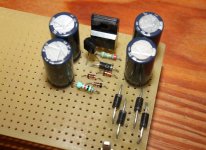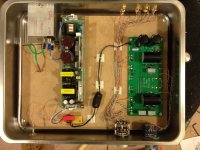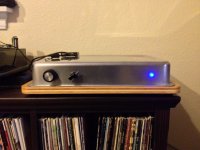In my experience a semi decent external smps, ferrites on the dc lead to the B1 and a CRCRC filter is perfectly good enough for a B1. Having said that I've not built the B1 variant with symmetrical supply and high quality regs described elsewhere in this forum, so can't comment on the level of gains that approach can offer.
The nice things about the external psu are:
Cheap and easy to build
No 50/100Hz mains hum issues (no linear supply within the B1 chassis with associated fields)
Easy to try different psus (linear/smps, different voltages etc)
If you have an existing psu that could do the job (old laptop charger etc) my recommendation would be to bash on with building the B1 as I'm sure you'll be very happy with the results. Once it's up and running you can play around with alternate supplies to your hearts content.
The nice things about the external psu are:
Cheap and easy to build
No 50/100Hz mains hum issues (no linear supply within the B1 chassis with associated fields)
Easy to try different psus (linear/smps, different voltages etc)
If you have an existing psu that could do the job (old laptop charger etc) my recommendation would be to bash on with building the B1 as I'm sure you'll be very happy with the results. Once it's up and running you can play around with alternate supplies to your hearts content.
As I understand regulated psu is not that important in b1 and ordinary laptop psu or similar is more than enough ?
that is regulated
but no, I dont think you need regulated supply
but ofcourse its much easier to use laptop supply
8.2uf 250v Cap
Can I use this value in place of the 10uf one spec'd? I have a few SCR's already.
Thx.
Can I use this value in place of the 10uf one spec'd? I have a few SCR's already.
Thx.
lausar....Regarding the output cap. If you consider the input impedance of the amplifier you'll be using the B1 with, you can have lower output capacitance. Try keep the -3dB frequency cutoff below 1 Hz and you will be fine. I used a 4.7uF and my input is 100K to the F5 I'm using. The 100K in parallel with the 220K on the B1 output and a 4.7uF gives a -3dB point of around 0.5 Hz and there is no lack of bass what so ever.
Here's my B1
Stock B1, used a 24v switcher power supply with a linear section to drop the voltage to 20.5v. Checked the PSU and audio outputs with a scope and found switcher noise in both so since these pics I added a larger inductor to drop it down. Its minimal now.
Sounds great and yes I built it in an upside down Ikea baking tray (stainless steel) with a plywood wooden bottom.
Can't decide whether or not to add the Pass DIY sticker or not (or where?).
Its feeding my penultimate zen amp and is fed by a ODAC DAC and an ESP battery powered phono stage from a Rega Planar TT.
Tip my hat to Mr Pass for making this all possible..
Chris
Stock B1, used a 24v switcher power supply with a linear section to drop the voltage to 20.5v. Checked the PSU and audio outputs with a scope and found switcher noise in both so since these pics I added a larger inductor to drop it down. Its minimal now.
Sounds great and yes I built it in an upside down Ikea baking tray (stainless steel) with a plywood wooden bottom.
Can't decide whether or not to add the Pass DIY sticker or not (or where?).
Its feeding my penultimate zen amp and is fed by a ODAC DAC and an ESP battery powered phono stage from a Rega Planar TT.
Tip my hat to Mr Pass for making this all possible..
Chris
Attachments
Stock B1, used a 24v switcher power supply with a linear section to drop the voltage to 20.5v. Checked the PSU and audio outputs with a scope and found switcher noise in both so since these pics I added a larger inductor to drop it down. Its minimal now.
Sounds great and yes I built it in an upside down Ikea baking tray (stainless steel) with a plywood wooden bottom.
Can't decide whether or not to add the Pass DIY sticker or not (or where?).
Its feeding my penultimate zen amp and is fed by a ODAC DAC and an ESP battery powered phono stage from a Rega Planar TT.
Tip my hat to Mr Pass for making this all possible..
Chris
Looks great Chris. If I might make an improvement suggestion it would be to change the Solen fastcaps with something much much better and will not break the bank. I used Robert Hovland supercaps and must say they are really superior caps. They made the use of caps transparent in my B1 + F5 system.
I am looking for a good stepped attenuator (volume control) with the least clik-clik, most smooth rotation. Is it Goldpoint or Dact better or etc., please suggestions/comments anyone.
"Stepped attenuator" and "least clik-clik" are two terms that don't usually apply to one thing.
A stepped attenuator is, by design, going to click at each detent because it has to. It is a switch, not a wiper, and has to find the detent without being in the middle of 2 contacts.
If you want the performance of a stepped attenuator with a smooth dial, you could try the 'joshua tree' from Twisted Pear Audio -- the dial itself is a rotary encoder that drives a relay bank. AMB audio also has something similar.
A stepped attenuator is, by design, going to click at each detent because it has to. It is a switch, not a wiper, and has to find the detent without being in the middle of 2 contacts.
If you want the performance of a stepped attenuator with a smooth dial, you could try the 'joshua tree' from Twisted Pear Audio -- the dial itself is a rotary encoder that drives a relay bank. AMB audio also has something similar.
Thanks for your feedback. I understand that a real potentiometer would be the best; just wanted to understand which one of Goldpoint, DACT, Valab is better in terms of smooth rotation, feeling and clicks (mechanical and sound clicks wise). Just a comparison between them.
Thanks, I understood. Is anyone else has an experience comparing between those three, which ever is better-more smooth, only from those three?
Attenuators
I have a Goldpoint in my daily use B1 and it is first rate.
There is no noise when adjusting level.
I have A/B compared it to an Audio Research sp14 and it excels.
I have a ladder type from the hifi collective in the UK that I have not used yet... it is going into a new B1 build but it will a month or so before I get to that.
In the meantime I can tell you from personal experience that you will not be disappointed with Goldpoint.
DB in MN
- 15f @ 11:30pm
I have a Goldpoint in my daily use B1 and it is first rate.
There is no noise when adjusting level.
I have A/B compared it to an Audio Research sp14 and it excels.
I have a ladder type from the hifi collective in the UK that I have not used yet... it is going into a new B1 build but it will a month or so before I get to that.
In the meantime I can tell you from personal experience that you will not be disappointed with Goldpoint.
DB in MN
- 15f @ 11:30pm
bassnkeys, thanks for your detailed answer, this kind of information I was looking!
I will be ordering Goldpoint Mini V series.
I was trying to be proactive, was browsing avsforum.com forums and found more valuable info, thought would be interesting to DIY-elfers, provided by Wes from Tisbury Audio (UK):
I will be ordering Goldpoint Mini V series.
I was trying to be proactive, was browsing avsforum.com forums and found more valuable info, thought would be interesting to DIY-elfers, provided by Wes from Tisbury Audio (UK):
I've tried and tested most attenuators on the market, so I thought I could offer a bit of helpful insight.
All stepped attenuators will have a detended rotation as this is required to ensure the wiper settles correctly on each step. However some are smoother than others.
DACT & Goldpoint: These both use the same Elma switch, so both feel the same. The rotation is noticeably stepped, but switching between steps is smooth and effortless. These are both serial types (I'll cover different types and their impedances below).
Dale attenuators: These have a much stiffer rotation. They offer brilliant sound quality, channel matching and price, but the stiffness is a real downer. You can get them in serial, ladder or shunt configuration. I'd only ever recommend ladder for these.
Chinese SMD attenuators: These are available on eBay from gigawork and lasercollection for about $10.
I actually really like these. They have by far the smoothest rotation of all the attenuators. You can feel the steps, but they're very smooth.
They're serial surface mount resistor types, the same as DACT & Goldpt. They sound great and have good channel matching.
Because of the price, there have been concerns on other forums about build quality, but I've not personally had any problems. Plus they're so cheap you can just buy 2 or 3.
Seiden/Shallco: These use a spring loaded ball against a cog to step the rotation, so as you can imagine the rotation goes 'clunk, clunk'. They're very expensive, and the main advantage over DACT/Goldpt is that they can be made in any configuration and with any resistors.
(Wes from Tisbury Audio)
Last edited:
Gain
Just about complete with my B1 build. I have just one input and one output connect for now just to test it out while I'm waiting on some RCA jacks to arrive.
Fired here up and put on a Coltrane CD...sounds great but It's really loud on my PEC 25K linear pot at 10 o'clock. Is this normal? I thought I was going to gain some range.
My system:
Altec spaekers 96dB
Toshiba DVD/CD Player
Charkize2 T-amp
Just about complete with my B1 build. I have just one input and one output connect for now just to test it out while I'm waiting on some RCA jacks to arrive.
Fired here up and put on a Coltrane CD...sounds great but It's really loud on my PEC 25K linear pot at 10 o'clock. Is this normal? I thought I was going to gain some range.
My system:
Altec spaekers 96dB
Toshiba DVD/CD Player
Charkize2 T-amp
Normal
The efficiency of your speakers will make the biggest difference in how much signal you'll need.
The good part is that you will probably never come close to needing all the drive from your source components showing that you are in the perfect position to use a buffer rather than another gain stage.
If you had 86db speakers you'd find yourself using a bunch more range on that pot.
I have some low efficiency (85db) speakers as my main system and using a 25k pot low listening levels are around 9 o'clock and serious listening levels show up between 12 o'clock and just past 2 o'clock depending on the recording.
The efficiency of your speakers will make the biggest difference in how much signal you'll need.
The good part is that you will probably never come close to needing all the drive from your source components showing that you are in the perfect position to use a buffer rather than another gain stage.
If you had 86db speakers you'd find yourself using a bunch more range on that pot.
I have some low efficiency (85db) speakers as my main system and using a 25k pot low listening levels are around 9 o'clock and serious listening levels show up between 12 o'clock and just past 2 o'clock depending on the recording.
Last edited:
Log Taper
Just switched in a Log Taper PEC 50K pot. Mo better! 6-2 o'clock range now with nice low-level range too.
I wonder what results Nelson got with his Lowther set-up. That's a high efficiency speaker.
The efficiency of your speakers will make the biggest difference in how much signal you'll need.
The good part is that you will probably never come close to needing all the drive from your source components showing that you are in the perfect position to use a buffer rather than another gain stage.
If you had 86db speakers you'd find yourself using a bunch more range on that pot.
I have some low efficiency (85db) speakers as my main system and using a 25k pot low listening levels are around 9 o'clock and serious listening levels show up between 12 o'clock and just past 2 o'clock depending on the recording.
Just switched in a Log Taper PEC 50K pot. Mo better! 6-2 o'clock range now with nice low-level range too.
I wonder what results Nelson got with his Lowther set-up. That's a high efficiency speaker.
I've tried and tested most attenuators on the market, so I thought I could offer a bit of helpful insight.
All stepped attenuators will have a detended rotation as this is required to ensure the wiper settles correctly on each step. However some are smoother than others.
DACT & Goldpoint: These both use the same Elma switch, so both feel the same. The rotation is noticeably stepped, but switching between steps is smooth and effortless. These are both serial types (I'll cover different types and their impedances below).
Dale attenuators: These have a much stiffer rotation. They offer brilliant sound quality, channel matching and price, but the stiffness is a real downer. You can get them in serial, ladder or shunt configuration. I'd only ever recommend ladder for these.
Chinese SMD attenuators: These are available on eBay from gigawork and lasercollection for about $10.
I actually really like these. They have by far the smoothest rotation of all the attenuators. You can feel the steps, but they're very smooth.
They're serial surface mount resistor types, the same as DACT & Goldpt. They sound great and have good channel matching.
Because of the price, there have been concerns on other forums about build quality, but I've not personally had any problems. Plus they're so cheap you can just buy 2 or 3.
Seiden/Shallco: These use a spring loaded ball against a cog to step the rotation, so as you can imagine the rotation goes 'clunk, clunk'. They're very expensive, and the main advantage over DACT/Goldpt is that they can be made in any configuration and with any resistors.
(Wes from Tisbury Audio)
Elma also uses spring loaded ball against the teeth cog, it's just hidden in the front part of the body. Actually the spring might be exchange for softer one making operating easier/smoother. I even once removed it so you pretty much no longer can hear tthe position and it worked perfect with ladder type. The Elma wasn't loose without the ball/spring but still little tight not to move itself.
There is one more thing about the clicks and pops in the speakers while changing the volume. Even if it's make before brake switch it is never perfect but what is important is that ladder type is always much more prone to those clicks becouse unlike the series and shunt it brakes both connection while the series and shunt behave just like the wiper in the pot.
- Status
- Not open for further replies.
- Home
- Amplifiers
- Pass Labs
- B1 builders thread


